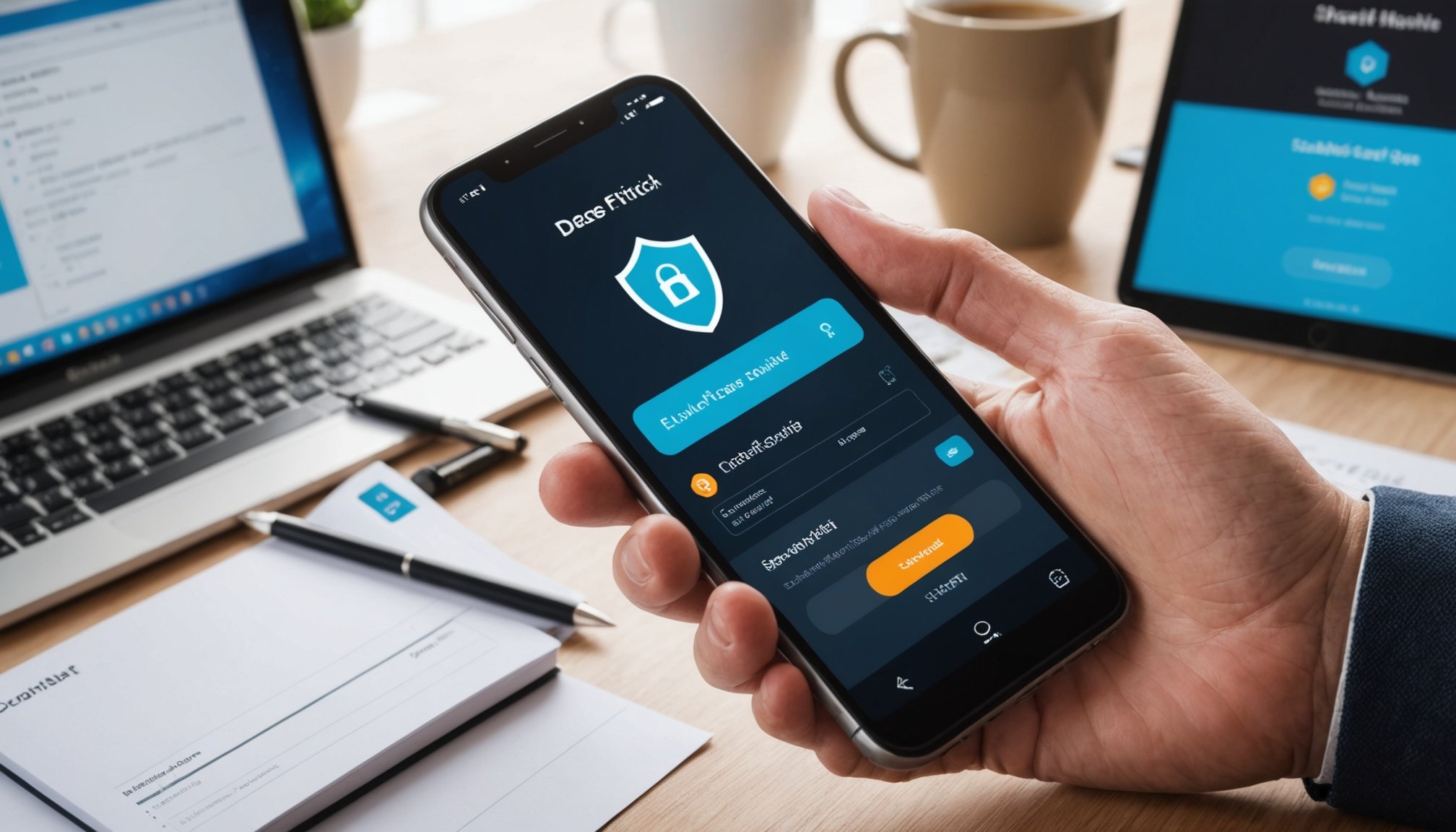Top Strategies to Boost Mobile App Security for Fintech Firms in the UK
In the rapidly evolving fintech landscape, ensuring the security of mobile apps is more crucial than ever. With the increasing reliance on mobile banking and financial services, fintech companies in the UK must implement robust security measures to protect sensitive financial data and maintain user trust. Here’s a comprehensive guide on the top strategies to enhance mobile app security for fintech firms.
Understanding the Fintech Security Landscape
The fintech industry is a prime target for cybercriminals due to the sensitive nature of the financial data it handles. According to recent reports, the finance industry suffered the most number of data breaches in 2023, highlighting the urgent need for enhanced security measures[2].
In parallel : Unlocking the Power of AI: Top Strategies for Boosting Fashion Product Recommendations on UK e-Commerce Sites
“Data risks are arguably the gravest concern that CTOs face when scaling their fintech software. As you’re aware, fintech software is a likely target for cybercriminals,” notes an expert from Uptech[2].
Regulatory Compliance: A Cornerstone of Fintech Security
Regulatory compliance is a critical aspect of fintech app development. Fintech companies must adhere to a myriad of regulations, including the General Data Protection Regulation (GDPR), the Gramm-Leach-Bliley Act (GLBA), and Anti-Money Laundering (AML) laws.
Also read : Unlocking Success: The Advantages of Cloud-Based Project Management Tools for Remote Teams in the UK
Key Regulatory Requirements
- GDPR: Regulates how businesses collect and use customer data in the European Union.
- GLBA: Governs how financial institutions in the US manage and secure sensitive customer information.
- AML: Ensures compliance with laws aimed at preventing money laundering.
- PSD2: The Payment Services Directive 2, which regulates payment services in the EU[2][3].
To stay compliant, fintech companies should:
- Set up an internal compliance audit team.
- Apply data privacy measures such as encryption and user authentication.
- Update fintech products promptly according to regulatory changes.
- Automate compliance monitoring and risk management with AI and machine learning[2].
Implementing Robust Security Measures
Security is the backbone of any fintech app. Here are some best practices to ensure your mobile app is secure:
Multi-Factor Authentication
Multi-factor authentication (MFA) adds an extra layer of security by requiring users to provide two or more verification factors to gain access. This can include passwords, biometric data, or one-time passwords sent via SMS or email.
Encryption
Encrypting data both in transit and at rest is crucial. This ensures that even if data is intercepted or accessed unauthorized, it remains unreadable without the decryption key.
Real-Time Fraud Detection
Implementing real-time fraud detection systems can help identify and prevent fraudulent activities. These systems use machine learning algorithms to analyze user behavior and flag suspicious transactions[1][3].
Secure Coding Practices
Practicing secure coding is essential to prevent latent vulnerabilities. This includes regular code reviews, secure coding guidelines, and the use of secure development frameworks.
Periodical Security Audits
Conducting regular security audits helps identify and remediate security flaws promptly. This includes penetration testing and vulnerability assessments to ensure the app’s security posture is robust[2].
Leveraging Advanced Security Technologies
Zero Trust Network Access (ZTNA)
ZTNA is a security strategy that assumes no user or device is trustworthy by default. It requires continuous verification and authorization before granting access to sensitive data. This approach is particularly useful in the era of remote work and cloud adoption.
“Zero Trust Network Access (ZTNA) is a strategy that is taking the world by storm and is essential for fintech security,” highlights a thought leader on fintech security[4].
Blockchain and Decentralized Finance (DeFi)
Blockchain technology offers secure, transparent, and immutable transactions. DeFi solutions built on blockchain enable decentralized lending, borrowing, and trading, providing users with more flexibility and control over their finances[3].
Biometric Authentication
Biometric authentication, such as facial recognition or fingerprint scans, provides an additional layer of security and convenience. This method uses unique biological characteristics to verify user identities[4].
Ensuring Scalability and Reliability
Fintech apps must be designed to handle large transaction volumes and user traffic, especially during peak periods. Here are some strategies to ensure scalability and reliability:
Cloud Infrastructure
Using cloud infrastructure allows for high availability, elasticity, and fault tolerance. Cloud services like AWS or Azure provide scalable solutions that can handle increased traffic without compromising performance.
Load Balancing and Auto-Scaling
Implementing load balancing and auto-scaling ensures that the app can handle sudden spikes in traffic. This prevents downtime and ensures a seamless user experience.
Data Management and Analytics
Effective data management and analytics are crucial for fintech apps. Implementing data warehousing, predictive analytics, and AI-driven insights helps in making informed business decisions and improving user experience[1].
Best Practices in Fintech App Development
When developing a fintech app, several best practices can ensure the app is both secure and user-friendly.
Planning and Requirement Gathering
- Identify the target audience and their financial management needs.
- Conduct market research and competitive analysis to understand what current solutions offer and what they lack.
- Prioritize features based on user demands, budget, timeline, and tech stack.
- Ensure compliance with financial and industry-specific regulations[3].
Technology Stack and Platform
- Choose the appropriate tech stack based on the app’s requirements. For example, React.js and Node.js for web apps, Kotlin and Swift for native mobile apps, and React Native for cross-platform development.
- Integrate third-party financial services like payment processors, market data providers, and KYC/AML services.
- Implement strong security protocols such as data encryption and multi-factor authentication[3].
Testing and Quality Assurance (QA)
- Conduct thorough testing before the app’s release to ensure it functions properly and meets all standards.
- Perform security testing regularly to prevent, identify, and resolve vulnerability issues on time[3].
Practical Insights and Actionable Advice
Here are some practical tips for fintech companies looking to enhance their mobile app security:
Integrate Third-Party Services Wisely
Integrating third-party services like Stripe or PayPal can enhance security but also increases development costs. Ensure these services comply with required data privacy regulations and security standards[5].
Use Infrastructure as Code (IaC)
IaC is a modern approach to cloud-based security that ensures cloud configuration is dependable and scalable. This approach helps address cloud configuration complications effectively[4].
Focus on User Experience
While security is paramount, it’s equally important to balance security with user-friendliness. Users should not be required to authenticate multiple times before performing simple tasks. Map the entire customer journey and design the app to support it seamlessly[2].
Case Study: Successful Fintech App Modernization
The Wholesale Floor Covering Credit Association of Canada (WFCCA) faced significant challenges with their outdated web portal. Here’s how they successfully modernized their fintech app:
Comprehensive Software Audit
Before starting the system upgrade, a comprehensive software audit was conducted to evaluate the current status of the system, identify issues, and prioritize necessary steps.
Code Refactoring and Bug Resolution
The MobiDev team managed to complete the system upgrade from Ruby 2.5.8, Ruby on Rails 5.2.4.2, and the Heroku 18 Stack, and resolve existing bugs in less than three months.
Improved User Experience
The successful upgrading efforts ensured the stability and smooth functionality of their portal, keeping users satisfied with the improved application performance[1].
Ensuring the security of fintech mobile apps is a multifaceted challenge that requires a combination of regulatory compliance, robust security measures, advanced technologies, and best practices in app development. By prioritizing these strategies, fintech companies in the UK can protect sensitive financial data, maintain user trust, and stay ahead in the competitive fintech industry.
Table: Comparative Overview of Key Security Measures
| Security Measure | Description | Benefits | Implementation Challenges |
|---|---|---|---|
| Multi-Factor Authentication | Requires users to provide two or more verification factors. | Adds an extra layer of security, reduces the risk of unauthorized access. | Can be inconvenient for users if not implemented correctly. |
| Encryption | Encrypts data both in transit and at rest. | Ensures data remains unreadable without the decryption key. | Requires robust key management and can impact performance. |
| Zero Trust Network Access (ZTNA) | Assumes no user or device is trustworthy by default. | Provides continuous verification and authorization, reducing the risk of cyberattacks. | Requires significant infrastructure changes and ongoing monitoring. |
| Biometric Authentication | Uses unique biological characteristics to verify user identities. | Offers additional security and convenience. | Raises privacy concerns and can be vulnerable to spoofing attacks. |
| Regular Security Audits | Identifies and remediates security flaws promptly. | Ensures the app’s security posture is robust and up-to-date. | Requires ongoing resources and can be time-consuming. |
| Secure Coding Practices | Prevents latent vulnerabilities through secure coding guidelines and regular code reviews. | Ensures the app is developed with security in mind from the outset. | Requires skilled developers and ongoing training. |
Detailed Bullet Point List: Steps to Ensure Fintech App Security
-
Regulatory Compliance:
-
Set up an internal compliance audit team.
-
Apply data privacy measures such as encryption and user authentication.
-
Update fintech products promptly according to regulatory changes.
-
Automate compliance monitoring and risk management with AI and machine learning.
-
Robust Security Measures:
-
Implement multi-factor authentication.
-
Encrypt data both in transit and at rest.
-
Use real-time fraud detection systems.
-
Practice secure coding to prevent latent vulnerabilities.
-
Conduct periodical security audits to identify and remediate security flaws.
-
Advanced Security Technologies:
-
Implement Zero Trust Network Access (ZTNA).
-
Use blockchain and decentralized finance (DeFi) solutions.
-
Integrate biometric authentication for added security and convenience.
-
Scalability and Reliability:
-
Use cloud infrastructure for high availability, elasticity, and fault tolerance.
-
Implement load balancing and auto-scaling to handle sudden spikes in traffic.
-
Ensure effective data management and analytics.
-
Best Practices in App Development:
-
Plan and gather requirements carefully.
-
Choose the appropriate tech stack based on the app’s requirements.
-
Integrate third-party financial services wisely.
-
Conduct thorough testing before the app’s release.
-
Focus on user experience while ensuring security.
By following these strategies and best practices, fintech companies can significantly enhance the security of their mobile apps, protecting sensitive financial data and maintaining user trust in the digital age.











